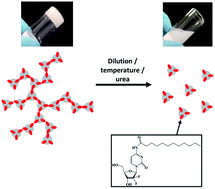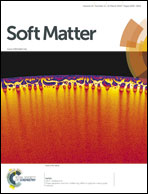An innovative hydrogel of gemcitabine-loaded lipid nanocapsules: when the drug is a key player of the nanomedicine structure
Abstract
A new method to form a nanoparticle-structured hydrogel is reported; it is based on the drug being loaded into the nanoparticles to form a solid structure. A lipophilic form of gemcitabine (modified lauroyl), an anti-cancer drug, was encapsulated in lipid nanocapsules (LNCs), using a phase-inversion temperature process. A gel was formed spontaneously, depending on the LNC concentration. The drug loading, measured with total entrapment efficiency, and the rheological properties of the gel were assessed. Physical studies (surface tension measurements) showed that modified gemcitabine was localised at the oil–water interface of the LNC, and that the gemcitabine moieties of the prodrug were exposed to the water phase. This particular assembly promoted inter-LNC interactions via hydrogen bonds between gemcitabine moieties that led to an LNC gel structure in water, without a matrix, like a tridimensional pearl necklace. Dilution of the gel produced a gemcitabine-loaded LNC suspension in water, and these nanoparticles presented cytotoxic activity to various cancer cell lines to a greater degree than the native drug. Finally, the syringeability of the formulation was successfully tested and perspectives of its use as a nanomedicine (intratumoural or subcutaneous injection) can be foreseen.


 Please wait while we load your content...
Please wait while we load your content...